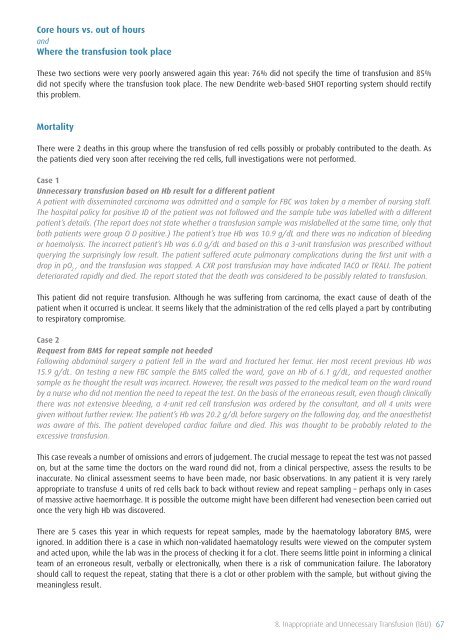SHOT Annual Report 2009 - Serious Hazards of Transfusion
SHOT Annual Report 2009 - Serious Hazards of Transfusion
SHOT Annual Report 2009 - Serious Hazards of Transfusion
You also want an ePaper? Increase the reach of your titles
YUMPU automatically turns print PDFs into web optimized ePapers that Google loves.
Core hours vs. out <strong>of</strong> hours<br />
and<br />
Where the transfusion took place<br />
These two sections were very poorly answered again this year: 76% did not specify the time <strong>of</strong> transfusion and 85%<br />
did not specify where the transfusion took place. The new Dendrite web-based <strong>SHOT</strong> reporting system should rectify<br />
this problem.<br />
Mortality<br />
There were 2 deaths in this group where the transfusion <strong>of</strong> red cells possibly or probably contributed to the death. As<br />
the patients died very soon after receiving the red cells, full investigations were not performed.<br />
Case 1<br />
Unnecessary transfusion based on Hb result for a different patient<br />
A patient with disseminated carcinoma was admitted and a sample for FBC was taken by a member <strong>of</strong> nursing staff.<br />
The hospital policy for positive ID <strong>of</strong> the patient was not followed and the sample tube was labelled with a different<br />
patient’s details. (The report does not state whether a transfusion sample was mislabelled at the same time, only that<br />
both patients were group O D positive.) The patient’s true Hb was 10.9 g/dL and there was no indication <strong>of</strong> bleeding<br />
or haemolysis. The incorrect patient’s Hb was 6.0 g/dL and based on this a 3-unit transfusion was prescribed without<br />
querying the surprisingly low result. The patient suffered acute pulmonary complications during the first unit with a<br />
drop in pO 2<br />
, and the transfusion was stopped. A CXR post transfusion may have indicated TACO or TRALI. The patient<br />
deteriorated rapidly and died. The report stated that the death was considered to be possibly related to transfusion.<br />
This patient did not require transfusion. Although he was suffering from carcinoma, the exact cause <strong>of</strong> death <strong>of</strong> the<br />
patient when it occurred is unclear. It seems likely that the administration <strong>of</strong> the red cells played a part by contributing<br />
to respiratory compromise.<br />
Case 2<br />
Request from BMS for repeat sample not heeded<br />
Following abdominal surgery a patient fell in the ward and fractured her femur. Her most recent previous Hb was<br />
15.9 g/dL. On testing a new FBC sample the BMS called the ward, gave an Hb <strong>of</strong> 6.1 g/dL, and requested another<br />
sample as he thought the result was incorrect. However, the result was passed to the medical team on the ward round<br />
by a nurse who did not mention the need to repeat the test. On the basis <strong>of</strong> the erroneous result, even though clinically<br />
there was not extensive bleeding, a 4-unit red cell transfusion was ordered by the consultant, and all 4 units were<br />
given without further review. The patient’s Hb was 20.2 g/dL before surgery on the following day, and the anaesthetist<br />
was aware <strong>of</strong> this. The patient developed cardiac failure and died. This was thought to be probably related to the<br />
excessive transfusion.<br />
This case reveals a number <strong>of</strong> omissions and errors <strong>of</strong> judgement. The crucial message to repeat the test was not passed<br />
on, but at the same time the doctors on the ward round did not, from a clinical perspective, assess the results to be<br />
inaccurate. No clinical assessment seems to have been made, nor basic observations. In any patient it is very rarely<br />
appropriate to transfuse 4 units <strong>of</strong> red cells back to back without review and repeat sampling – perhaps only in cases<br />
<strong>of</strong> massive active haemorrhage. It is possible the outcome might have been different had venesection been carried out<br />
once the very high Hb was discovered.<br />
There are 5 cases this year in which requests for repeat samples, made by the haematology laboratory BMS, were<br />
ignored. In addition there is a case in which non-validated haematology results were viewed on the computer system<br />
and acted upon, while the lab was in the process <strong>of</strong> checking it for a clot. There seems little point in informing a clinical<br />
team <strong>of</strong> an erroneous result, verbally or electronically, when there is a risk <strong>of</strong> communication failure. The laboratory<br />
should call to request the repeat, stating that there is a clot or other problem with the sample, but without giving the<br />
meaningless result.<br />
8. Inappropriate and Unnecessary <strong>Transfusion</strong> (I&U) 67












